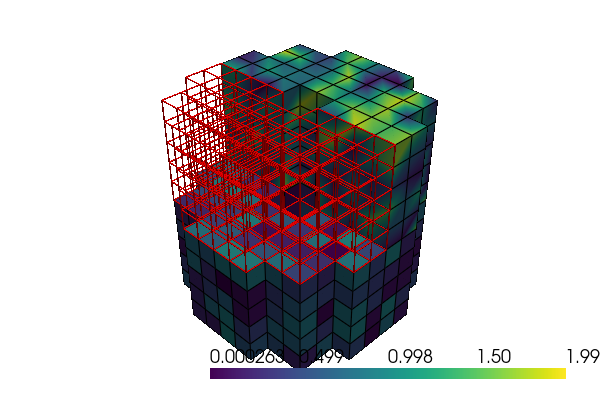This page was generated from
docs\source\examples/compound2.ipynb.
Plotting with scalar data#
We are about to build a compound mesh by transforming parts of a voxlized cylinder into tetrahedra and lines. Then we do some plotting and review the basics of configuring plots.
The notebook requires the
asciitreepackage to be installed.
[1]:
from sigmaepsilon.mesh.space import CartesianFrame
from sigmaepsilon.mesh.recipes import cylinder
from sigmaepsilon.mesh import PolyData, LineData, PointData
from sigmaepsilon.mesh.cells import H8, Q4, L2
from sigmaepsilon.mesh.utils.topology import H8_to_L2, H8_to_Q4
from sigmaepsilon.mesh.utils.topology import detach_mesh_bulk
from sigmaepsilon.mesh.utils.space import frames_of_lines, frames_of_surfaces
from sigmaepsilon.math import minmax
from sigmaepsilon.deepdict import asciiprint
import numpy as np
min_radius = 5
max_radius = 25
h = 50
angle = 1
shape = (min_radius, max_radius), angle, h
frame = CartesianFrame(dim=3)
cyl = cylinder(shape, size=5.0, voxelize=True, frame=frame)
coords = cyl.coords()
topo = cyl.topology().to_numpy()
centers = cyl.centers()
cxmin, cxmax = minmax(centers[:, 0])
czmin, czmax = minmax(centers[:, 2])
cxavg = (cxmin + cxmax) / 2
czavg = (czmin + czmax) / 2
b_upper = centers[:, 2] > czavg
b_lower = centers[:, 2] <= czavg
b_left = centers[:, 0] < cxavg
b_right = centers[:, 0] >= cxavg
iL2 = np.where(b_upper & b_right)[0]
iTET4 = np.where(b_upper & b_left)[0]
iH8 = np.where(b_lower)[0]
_, tL2 = H8_to_L2(coords, topo[iL2])
_, tQ4 = H8_to_Q4(coords, topo[iTET4])
tH8 = topo[iH8]
pd = PointData(coords=coords, frame=frame)
mesh = PolyData(pd, frame=frame)
cdL2 = L2(topo=tL2, frames=frames_of_lines(coords, tL2))
mesh["lines", "L2"] = LineData(cdL2, frame=frame)
cdQ4 = Q4(topo=tQ4, frames=frames_of_surfaces(coords, tQ4))
mesh["surfaces", "Q4"] = PolyData(cdQ4, frame=frame)
cH8, tH8 = detach_mesh_bulk(coords, tH8)
pdH8 = PointData(coords=cH8, frame=frame)
cdH8 = H8(topo=tH8, frames=frame)
mesh["bodies", "H8"] = PolyData(pdH8, cdH8, frame=frame)
mesh.to_standard_form()
mesh.lock(create_mappers=True)
asciiprint(mesh)
PolyData
+-- lines
| +-- L2
+-- surfaces
| +-- Q4
+-- bodies
+-- H8
We can assign colors by setting numerical data on points or cells. All we have to do is to provide the keyword argument scalars to PyVista. One way to do that is to add these walues to the configuration of your block of choice. For example, to set random data on H8 hexagonals, do this:
[2]:
mesh["lines", "L2"].config["pyvista", "plot", "color"] = "red"
mesh["lines", "L2"].config["pyvista", "plot", "line_width"] = 1.5
mesh["lines", "L2"].config["pyvista", "plot", "render_lines_as_tubes"] = True
mesh["bodies", "H8"].config["pyvista", "plot", "scalars"] = np.random.rand(tH8.shape[0])
ncTET4 = mesh["surfaces", "Q4"].coords(from_cells=True).shape[0]
mesh["surfaces", "Q4"].config["pyvista", "plot", "scalars"] = 2 * np.random.rand(ncTET4)
mesh["surfaces", "Q4"].config["pyvista", "plot", "opacity"] = 1.0
mesh.pvplot(
notebook=True,
jupyter_backend="static",
window_size=(600, 400),
config_key=["pyvista", "plot"],
cmap="plasma",
theme="document",
)

[3]:
import pyvista as pv
plotter = pv.Plotter(theme=pv.themes.DocumentTheme())
plotter = mesh.pvplot(
plotter=plotter,
config_key=["pyvista", "plot"],
return_plotter=True,
)
plotter.show(jupyter_backend="static", window_size=(600, 400))
